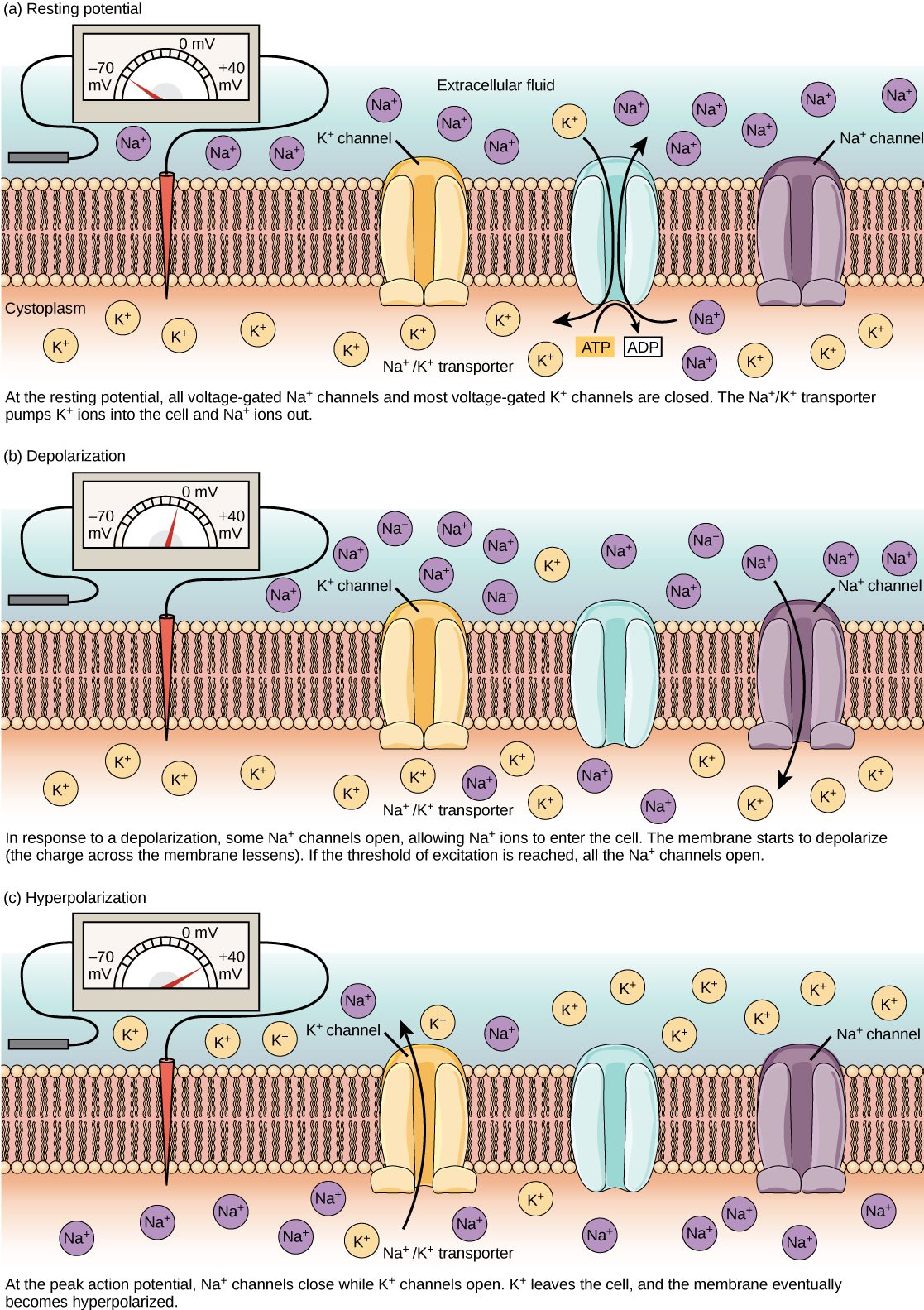Playlist
Show Playlist
Hide Playlist
Ion Manipulation
-
Slides 04 MembraneExcitability GeneralPhysiology.pdf
-
Download Lecture Overview
00:01 Now, we have membrane potential down, what do we know that’s most important? Potassium, potassium, potassium, potassium. 00:10 Potassium is very important for resting membrane potential. 00:15 Let’s manipulate it a little bit because you won’t always have the same potassium concentrations, right? There are times when you have high potassium, there’s times when you have low potassium. 00:27 How does that change membrane potential? So if we have our cell here at minus 70, it’s normally leaking out some potassium. 00:36 That’s very normal, sodium-potassium pump rotates some of it back in. 00:41 If you are in a hypokalemic state, meaning there’s now low potassium in the extracellular space, so that’s the interstitial fluid and the plasma, have low potassium. 00:57 How does this change membrane potential? More potassium will want to leave the cell because the concentration gradient is higher, that hyper polarizes the cell and makes it more negative. 01:15 You can see the more negative here within oscilloscope tracing. 01:20 So what you’re doing is moving more potassium out of the cell. 01:25 It’s getting closer to this minus 90 value. 01:31 If you actually measure it, you can get all the way to minus 90 in a hypokalemic environment. 01:39 What if you start with a membrane potential that’s normally about minus 70, you have the normal potassium leak out of the cell, and now, instead of hypokalemia, we’re in hyperkalemia. 01:51 We have a high amount of potassium outside the cell. 01:56 This could be for many different reasons. 01:59 It could be because other cells in the body are pushing its potassium out of the cell, which sometimes happens during an acidosis. 02:08 It could also be that you have dietarily intaked more potassium than you need. 02:15 So if you’re in a hyperkalemic environment, membrane potential rises. 02:23 It becomes less negative. 02:26 There is less of a driving force for potassium to want to lead the cell. 02:31 It’s inhibited because the driving force is not there to the same extent. 02:38 So we call that movement from minus 70 to minus 50 a depolarization. 02:47 If you haven’t reached threshold yet, that’s okay. 02:49 That’s an action potential. 02:51 We’ll get to that soon. 02:52 But what you’re doing is depolarizing. 02:55 If you go from minus 70 to a lower number, we are hyperpolarizing. 03:02 It’s easy to think of these two values if you look at them on a graph that uses membrane potential. 03:09 Going up is depolarization, going down is hyperpolarization. 03:18 Having a different concentration isn’t the only thing that affects membrane potential. 03:25 Currents can also change membrane potential. 03:29 For example, once you open up channels that were initially closed. 03:35 So what we have initially closed? We had sodium channels closed, calcium channels were close, chloride channels were closed. 03:43 What happens if you open them up? Membrane potential changes. 03:49 So here, this is showing you an example of opening up a sodium channel and you can see a large change in membrane potential as there’s an inward flux of sodium. 04:03 So sodium influx allows for a depolarization. 04:07 Why? Because it’s Nernst equation value was around 61 millivolts. 04:14 So as it travels in, membrane potential rises. 04:19 How about potassium? If you opened up even more potassium channels than what are open at rest, how would that change membrane potential? In this case, you would have a loss of potassium so that would hyperpolarize the membrane. 04:37 The conductance moves out, but the voltage goes down. 04:43 So you can see how currents change this whole process.
About the Lecture
The lecture Ion Manipulation by Thad Wilson, PhD is from the course Membrane Physiology.
Included Quiz Questions
In a normal excitable cell, an inward Na+ current is measured. How would this alter membrane potential?
- Depolarization would occur.
- Membrane potential would be equalized.
- Hyperpolarization would occur.
- The membrane potential would become more negative.
- An outflow of potassium would compensate for the excess sodium in the ICF.
What is the normal membrane resting potential for a regular cell?
- -70mV
- -90mV
- -60mV
- -100mV
- -50mV
Hypokalemia is present in the ECF around a normally excitable cell. How does this alter membrane potential?
- It would hyperpolarize.
- It would depolarize.
- It would equalize the membrane potential.
- It would make the membrane potential more positive.
- It would cause an inflow of sodium to compensate for the loss of potassium into the ECF.
Which ion is crucial for resting membrane potential?
- Potassium
- Chloride
- Sodium
- Calcium
- HCO3-
What other force causes change in membrane potential?
- The opening of other ion channels.
- The loss of membrane proteins.
- The addition of membrane proteins.
- The closing of potassium channels
- The addition of more potassium channels.
According to the Nernst Equation, what would be caused by an influx of sodium ions?
- Depolarization
- Hyperpolarization
- Membrane potential would remain stable.
- Repolarization
- The influx of two different positive ions is required for a change in membrane potential to occur.
Customer reviews
5,0 of 5 stars
| 5 Stars |
|
1 |
| 4 Stars |
|
0 |
| 3 Stars |
|
0 |
| 2 Stars |
|
0 |
| 1 Star |
|
0 |
very clear and eazy to understand reccomended to whoever needs to study phisiology




